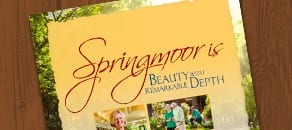By Thom Morgan, Springmoor landscape manager
 |
| Thom Morgan |
It’s a November morning, and I am standing in front of what will be the entrance to Springmoor’s new Wellness Center. Piles of dirt, broken concrete and construction materials surround the area. Large machines sit parked ready for another day of work. Somehow this soon will be a finished landscape, inviting residents, guests and employees in to use the new center. Where to start? There are no sidewalks in yet, which would indicate where plant beds go. There will be walkway lights, and other utilities that I must avoid covering with plants. There is a transformer box that will need to be hidden, and access to an existing transformer will need to be provided. I make note of other utilities such as a water faucet, which could come in handy. I know the sun will reach the area most of the morning, and into the early afternoon in summer. The main entry of the Wellness Center is on the southeast corner of the Valley building, so it will be well protected from cold winds in the winter. Fortunately, the builder provided me with a plan that indicates where the sidewalks, parking spaces, and lights go, and where windows and doors are located on the building. I now know how people will walk into and out of the building, as well as see into, and out of it. There is a large existing Willow Oak that should be saved.
This is the inventory, and analysis phase of the design now for a concept. It was very hard to come up with a design, but I wanted to simply match the purpose of the building–wellness–to the landscape. All of the plants in the plan can be used, or were used, for medicinal, herbal, or culinary purposes. The exception is a specimen Japanese maple, and some Encore azaleas–it’s OK to break some rules and not completely follow the concept; I can justify using the azaleas since they tie in nicely with what we have throughout campus. The Japanese maple–when matured–will have a peaceful, sculptural shape to it. Now it’s time to locate the plants on the plan. I will start out with the trees first, and choose those that meet the criteria for the wellness concept. I place the trees where they will provide shade from the hot summer sun, and also where they will be noticed as people walk into, and out of the building.
Dogwood (Cornus) bark was once used as a substitute for quinine.
Amelanchier (Serviceberry) has berries which are edible, and high in iron.
Sassafras albidium (sassafras) is the root-beer tree. The roots were boiled to make a tea, and not many plant nurseries carry them, but we have some native stands of Sassafras here at Springmoor. Sassafras gets great Fall color, and the leaves are very unusual. Leaves come in one lobe, two lobes, and three to four lobes all on the same tree.
Shrubs used in wellness concept:
Pyracantha (Fire thorn) have berries that were used in jams.
Calycanthus (Carolina sweetshrub) has bark that was once used as a substitute for cinnamon. It also has reddish-brown, fragrant flowers that bloom in April.
Gardenias (Gardenia sp.) will be used for their fragrance
Berberis thunbergii ‘ Crimson pygmy’ (Crimson pygmy barberry) will be planted along the southern wall by the pool which will get direct sun in the summer. Not only does barberry tolerate the heat, but it was once used for skin ailments.
Perennials used in wellness concept:
Rosemary officinalis (rosemary) will be used along with the barberry along the long walkway parallel to the pool. Rosemary is used in various dishes as an herb.
Achillea millefolium (yarrow) was once used for bleeding, and ulcers.
Lavendula (lavender) was used as an antiseptic.
Athrium filex-femina (lady fern) leaves were crushed, and used on burns and scrapes.
December Focal Points:
Witch hazel (Hamamelis vernalis) has yellow strap-like flowers blooming a month ahead of time. Two to three early November freezes most likely set if off.
Autumn Cherry (Prunus autumnalis) is a tree that blooms twice a year. December is when it first blooms, then they will bloom again in March.
Japanese Camellia (Camellia Japonica) pick up where the Sasanqua Camellia left off, so we get to enjoy both at the same time. The Japanese camellia will continue to bloom until March.
December Landscaping To-Do List:
- This is the last chance to plant fall bulbs such as daffodil, crocus, tulips, and hyacinth.
- This is a great time to plant large balled, and burlap trees.
- Accent your landscape with holiday lighting; consider choosing a smaller tree such as a crabapple, or Japanese maple as a holiday focal point.
- Toss the last of the Fall leaves into the compost pile.
- Fertilize fescue lawns to give them a boost for Winter.
Happy Holidays!



